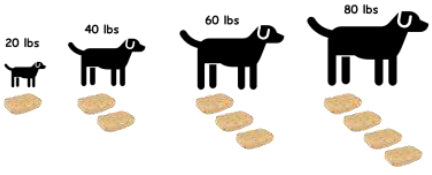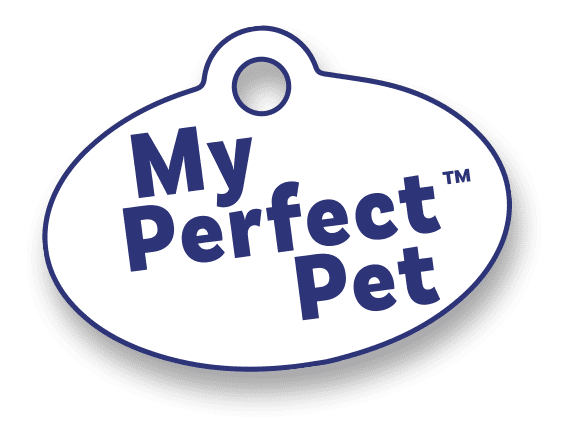Info

Thawing and Serving
Individual food bars are convenient for thawing and serving. We recommend thawing before serving to avoid any chance of your pet trying to swallow frozen pieces. The bars are best thawed in the refrigerator. However, if you find that it’s feeding time before the bars are thawed, you can do one of the following:
- Place a sealed bar in a bowl of warm water for a few minutes until thawed.
- We do not recommend microwaving. However, the plastic wrap is BPA-free and microwave-safe, the bars may be microwaved for a few seconds on DEFROST setting. DO NOT OVERHEAT!!! Test the temperature before serving to ensure there is no risk of burning your pet’s mouth.
Once thawed, food bars may be stored in the refrigerator for up to 3 days. Thawed bars may be refrozen without affecting the nutrition. Keep in mind refreezing does not reset the clock – if it was thawed in the refrigerator for 2 days, it will be day #3 when you thaw it again and it should be consumed that day.
Feeding Instructions
Quick links: For Dogs | For Puppies and Moms | For Cats | For Kittens and Moms
Daily Feeding Amounts for Dogs
Feeding instructions are based on average daily amounts for healthy, normally active dogs. Dogs with higher metabolisms or that are more active may require slightly higher amounts, and pets with slower metabolisms or that are less active may require slightly less.

We recommend feeding according to the pet’s IDEAL weight, not what they do weigh or would like to weigh! Because they love the delicious taste of baked meat and fresh whole food so much more, pet parents often interpret begging for more food as a sign of insufficient feeding. The best way to ensure proper feeding is to monitor your pet’s weight – this can easily be done without a scale by running your hand down the rib cage. You should feel a slight layer of fat over the ribs. Feeling nothing but the layer of fat is a sign that they are overweight. Feeling only bones indicates they should gain weight. Either way, feeling according to their IDEAL weight will ensure they get the nutrients they need and the right amount of caloric energy.
| If your dog weighs: | Feed this amount per day: |
|---|---|
| 10 lbs | 1/2 bar |
| 20 lbs | 1 bar |
| 30 lbs | 1.5 bars |
| 40 lbs | 2 bars |
| 50 lbs | 2.5 bars |
| 60 lbs | 3 bars |
| 80 lbs | 4 bars |
Note About Senior / Older Dogs
As dogs age, their systems become less efficient at digesting certain foods, and may require fewer calories as their metabolisms slow. Many companies offer senior or “lite” dog foods containing higher levels of non-digestible ingredients, or fillers, forcing their systems to work harder to digest and absorb nutrients. It is far better to keep them on a fresh whole food diet that is more easily digestible and packed with natural nutrients, and feed slightly less if they begin to put on excess weight.
Daily Feeding Amounts for Puppies and Gestating / Lactating Moms
Feeding instructions are based on average daily amounts for gestating or lactating moms and growing puppies. Puppies or moms with higher metabolisms or that are more active may require slightly higher amounts, while those with slower metabolisms or are less active may require slightly less.
We recommend feeding according to the pet’s IDEAL weight, not what they do weigh or would like to weigh! Because they love the delicious taste of baked meat and fresh whole food so much more, pet parents often interpret begging for more food as a sign of insufficient feeding. The best way to ensure proper feeding is to monitor your pet’s weight – this can easily be done without a scale by running your hand down the rib cage. You should feel a slight layer of fat over the ribs. Feeling nothing but the layer of fat is a sign that they are overweight. Feeling only bones indicates they should gain weight. Either way, feeling according to their IDEAL weight will ensure they get the nutrients they need and the right amount of caloric energy.
It is challenging to recommend an exact feeding amount during gestation and active growth, as the actual amount of food may vary depending on activity level and the age of the puppies. For the first few months of life, a puppy's growth and metabolism are at their highest and they require more calories and nutrients to build strong bones and teeth and foundation for life. As they age, and as skeletal growth slows, so does their need for these extra nutrients.
Our feeding recommendations are based on averages during active growth.
As the puppies growth slows, they should be slowly transitioned to the adult feeding amounts. Once lactation ends, moms should be transitioned back to normal adult feeding amounts.
| Mom/Puppy Weight: | Daily Feeding Amount: |
|---|---|
| 10 lbs | 1 bar |
| 15 lbs | 1.5 bars |
| 20 lbs | 2 bars |
| 30 lbs | 3 bars |
| 40 lbs | 4 bars |
| 50 lbs | 5 bars |
Daily Feeding Amounts for Cats
Feeding instructions are based on average daily amounts for healthy, normally active cats. Cats with higher metabolisms or that are more active may require slightly higher amounts, and pets with slower metabolisms or are less active may require slightly less.

We recommend feeding according to the cat’s IDEAL weight, not what they do weigh or would like to weigh! Because they love the delicious taste of baked meat and fresh whole food so much more, pet parents often interpret begging for more food as a sign of insufficient feeding. The best way to ensure proper feeding is to monitor your pet’s weight – this can easily be done without a scale by running your hand down the rib cage. You should feel a slight layer of fat over the ribs. Feeling nothing but the layer of fat is a sign that they are overweight. Feeling only bones indicates they should gain weight. Either way, feeling according to their IDEAL weight will ensure they get the nutrients they need and the right amount of caloric energy.
| If your cat weighs: | Feed this amount per day: |
|---|---|
| 5 lbs | 1/2 bar |
| 10 lbs | 1 bar |
| 15 lbs | 1.5 bars |
Daily Feeding Amounts for Kittens and Gestating / Lactating Moms
Feeding instructions are based on average daily amounts for healthy, normally active cats. Cats with higher metabolisms or that are more active may require slightly higher amounts, and pets with slower metabolisms or are less active may require slightly less.

We recommend feeding according to the cat’s IDEAL weight, not what they do weigh or would like to weigh! Because they love the delicious taste of baked meat and fresh whole food so much more, pet parents often interpret begging for more food as a sign of insufficient feeding. The best way to ensure proper feeding is to monitor your pet’s weight – this can easily be done without a scale by running your hand down the rib cage. You should feel a slight layer of fat over the ribs. Feeling nothing but the layer of fat is a sign that they are overweight. Feeling only bones indicates they should gain weight. Either way, feeling according to their IDEAL weight will ensure they get the nutrients they need and the right amount of caloric energy.
As the kittens growth slows, they should be slowly transitioned to the adult feeding amounts. Once lactation ends, moms should be transitioned back to normal adult feeding amounts.
| If your cat weighs: | Feed this amount per day: |
|---|---|
| 5 lbs | 1 bar |
| 10 lbs | 2 bars |
| 15 lbs | 3 bars |
Transitioning to Fresh
When transitioning from dry food to fresh food, we recommend the following transition:
| AMOUNT MY PERFECT PET: | AMOUNT DRY: | |
|---|---|---|
| Day 1 | 25% | 75% |
| Day 2 | 50% | 50% |
| Day 3 | 75% | 25% |
| Day 4 | 100% | 0% |
Most dogs can transition quickly and easily to fresh whole food, even with an overnight change. If your pet has an extremely sensitive digestive tract, we recommend slowing transition to 10% per day instead of 25%. After fully transitioning don’t be surprised to find your cleanup far easier and far less. Fresh whole food is more easily digested, and more of the nutrients being absorbed you will see less waste and cleanup.
